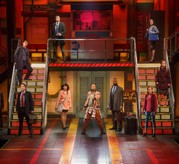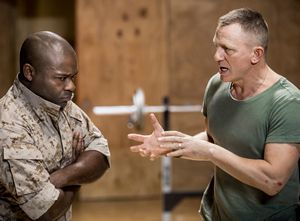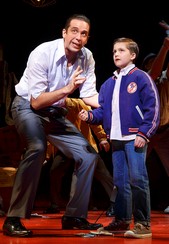
The Cast
That I had to be reminded
that I had previously seen and reviewed “In Transit” when it first appeared in
a Primary Stage production at 59E59 in 2010, suggests one or two things: it was
either negligible and forgettable or that its impact on me at the time was simply
that of a pleasant but passing diversion. Now I can say that the newly
envisioned version that has arrived at the Circle in the Square is once again diverting
but more importantly greatly accessorized and enhanced for Broadway.
This is the work of
director-choreographer Kathleen Marshall who has staged the show three quarters
in the round. Moving along like an express train, it has more moving parts, more
dazzling visual and lighting effects that had the previous version. A terrific
cast, all of whom are excellent singers, navigates through this show with
notable enthusiasm, often at break neck
speed. Unexpectedly captivating if also intentionally episodic, the show quickly
involves us with a group of rather ordinary, let's say unexceptional, men and
women. That they all become increasingly endearing as they go about their
various pursuits is the strength and the delight of “In Transit.”But what makes it exceptional is the musical
concept/conceit that drives the action: A Cappella, or group singing without
instrumental backup.
The composers — Kristen Anderson-Lopez, James-Allen Ford, Russ Kaplan and Sara Wordsworth — have created a patchwork of complex harmonics, melodies and riffs that define the show's various characters. The score also resounds admirably with the pulse and the sounds of the city.
Marshall keeps the highly energized company moving gingerly both in the subway and in their occasional forays above ground. Set designer Donyale Werle has created a commendably detailed depiction of a subway station on two levels with a moving tread mill down the center of the lower playing area. The crackling, often incomprehensible public address system gets laughs as does "attitude" from a nasty Booth Lady (Moya Angela, who also plays several other roles). There's an on-going conflict between her and Nate (James Snyder,) a young man laid off from his job in finance by the current recession who may never get to an important job interview because his metro card has been eaten up by a faulty machine.
Chessney Show (repeating his original role but alternating with Steven “Heaven” Cantor) is the street savvy Boxman and the show’s rhythmic, and sound effects-making centerpiece. He serves as a bridge to the other characters as he lyrically describes himself "It's Box for Boom Man, It's Box for Beat Man, It's Box for open, receptive and yet complete, Man." His virtuosic rap arias are integrated with some specifically non-human sounds, providing a generous helping of vocal support.
The Boxman is particularly supportive of Jane (Margo Seibert) the young aspiring actress with a temp job who is off to an audition and in whom he takes a friendly interest. He also helps Nate get through the turnstile. But don't expect Jane to turn into an overnight star or Nate to nail a great new job with a corner office. This being a musical, what you can expect is for Jane and Nate to add a touch of romance to the plot.
Trent (Justin Guarini) and Steven (Telly Leung) are also prominent as two gay guys who want to get married among the thirty-eight characters who traverse this lyrically-enhanced realm with big problems. Trent is particularly worried about their visit to his religious mother in Texas (Moya Angela again). Ali (Erin Mackey)recently broke up with her boyfriend and is destined (maybe) to spend all her Saturday nights alone. This is a musical that determinedly wants us to feel and share the anxieties and the stress of easily recognizable types in transit. If there is a purposefully prescribed banality to the overly familiar situations these people are facing, we are nevertheless inclined to be empathetic to the strengths and the sensibilities they reveal as resident and very typical New Yorkers.
All the performers are impressive as soloists as they are as backup singers for each other. If I find it difficult to single out specific songs, it is, nevertheless, easy to appreciate a musical in which the lyrics offer a multi-layered portrait of life in Manhattan. We don't often get to enjoy the purity of the a cappella musical, but this is one that winningly asserts itself with its lyrical and harmonic charms.
The composers — Kristen Anderson-Lopez, James-Allen Ford, Russ Kaplan and Sara Wordsworth — have created a patchwork of complex harmonics, melodies and riffs that define the show's various characters. The score also resounds admirably with the pulse and the sounds of the city.
Marshall keeps the highly energized company moving gingerly both in the subway and in their occasional forays above ground. Set designer Donyale Werle has created a commendably detailed depiction of a subway station on two levels with a moving tread mill down the center of the lower playing area. The crackling, often incomprehensible public address system gets laughs as does "attitude" from a nasty Booth Lady (Moya Angela, who also plays several other roles). There's an on-going conflict between her and Nate (James Snyder,) a young man laid off from his job in finance by the current recession who may never get to an important job interview because his metro card has been eaten up by a faulty machine.
Chessney Show (repeating his original role but alternating with Steven “Heaven” Cantor) is the street savvy Boxman and the show’s rhythmic, and sound effects-making centerpiece. He serves as a bridge to the other characters as he lyrically describes himself "It's Box for Boom Man, It's Box for Beat Man, It's Box for open, receptive and yet complete, Man." His virtuosic rap arias are integrated with some specifically non-human sounds, providing a generous helping of vocal support.
The Boxman is particularly supportive of Jane (Margo Seibert) the young aspiring actress with a temp job who is off to an audition and in whom he takes a friendly interest. He also helps Nate get through the turnstile. But don't expect Jane to turn into an overnight star or Nate to nail a great new job with a corner office. This being a musical, what you can expect is for Jane and Nate to add a touch of romance to the plot.
Trent (Justin Guarini) and Steven (Telly Leung) are also prominent as two gay guys who want to get married among the thirty-eight characters who traverse this lyrically-enhanced realm with big problems. Trent is particularly worried about their visit to his religious mother in Texas (Moya Angela again). Ali (Erin Mackey)recently broke up with her boyfriend and is destined (maybe) to spend all her Saturday nights alone. This is a musical that determinedly wants us to feel and share the anxieties and the stress of easily recognizable types in transit. If there is a purposefully prescribed banality to the overly familiar situations these people are facing, we are nevertheless inclined to be empathetic to the strengths and the sensibilities they reveal as resident and very typical New Yorkers.
All the performers are impressive as soloists as they are as backup singers for each other. If I find it difficult to single out specific songs, it is, nevertheless, easy to appreciate a musical in which the lyrics offer a multi-layered portrait of life in Manhattan. We don't often get to enjoy the purity of the a cappella musical, but this is one that winningly asserts itself with its lyrical and harmonic charms.


